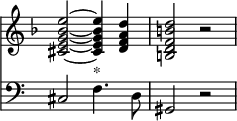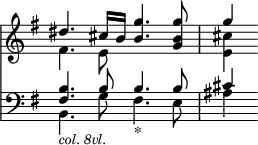for the purpose of classifying the chords, and of expounding the laws of their resolutions for the benefit of composers who might not be able otherwise to employ them correctly.
The actual number of essential chords has remained the same as it was when Monteverde indicated the nature of the Dominant seventh by using it without preparation, unless a single exception be made in favour of the chord of the major ninth and its sister the minor ninth, both of which Helmholtz acknowledges may be taken as representatives of the lower note or root; and it cannot be denied that they are both used with remarkable freedom, both in their preparation and resolution, by the great masters. Haydn, for instance, who is not usually held to be guilty of harmonic extravagance, uses the major ninth on the Dominant thus in his Quartet in G, Op. 76—

and the minor ninth similarly, and with as great freedom, as follows, in a Quartet in F minor (Trautwein, No. 3).

etc.
It is not possible to enter here into discussion of particular questions, such as the nature of the chord frequently called the 'Added Sixth,' to which theorists have proposed almost as many roots as the chord has notes; Rameau originally suggesting the Subdominant, German theorists the Supertonic as an inversion of a seventh, Mr. Alfred Day the Dominant, as an inversion of a chord of the eleventh, and Helmholtz returning to the Subdominant again in support of Rameau. Neither is it necessary to enter into particulars on the subject of the diminished seventh, which modern composers have found so useful for purposes of modulation, or into the devices of enharmonic changes, which are so fruitful in novel and beautiful effects, or into the discordance or non-discordance of the fourth. It is necessary for the sake of brevity to restrict ourselves as far as possible to things which illustrate general principles; and of these none are much more remarkable than the complicated use of suspensions and passing notes, which follow from the principles of Bach in polyphony as applied to harmony, and were remarked on above as laying the foundations of all the advance that has been made in Harmony since his time. Suspensions are now taken in any form and position which can in the first place be possibly prepared even by passing notes, or in the second place be possibly resolved even by causing a fresh discord, so long as the ultimate resolution into concord is feasible in an intelligible manner. Thus Wagner's Meistersinger opens with the phrase—
![{ \override Score.TimeSignature #'stencil = ##f \time 4/4 << \relative c'' { <c e, c>2 <g e c>4. g8 << { g2 ~ g8[ e] f } \\ { c2 } >> }
\new Staff { \clef bass \relative c { c2. b4 ~ b a a' s8 } } >> }](http://upload.wikimedia.org/score/g/1/g1avzcbd5loagdnkfsrfnhp9jy4t9dr/g1avzcbd.png)
etc.
in which B is a suspended passing note resolving so as to make a fresh discord with the treble, which in reality is resolved into another discord made by the appearance of a chromatic passing note, and does not find its way into an essential concord till three chords further on; but the example is sufficient to show the application of both principles as above expressed. One of the most powerful suspensions in existence is the following from Bach's Organ Toccata in D minor—

Of strongly accented passing notes the following are good examples—

etc.
from the Overture to the Messiah; and—

etc.
from Brahms's Ballade in D, which is practically the same passing note as that in the example from Handel, but passing in the opposite direction.
A good example of a succession of combinations resulting from the principles above enumerated with regard to the modification of diatonic notes, and the use of chromatic passing notes, occurs in Bach's Cantata, Christ unser Herr' (p. 208)—

